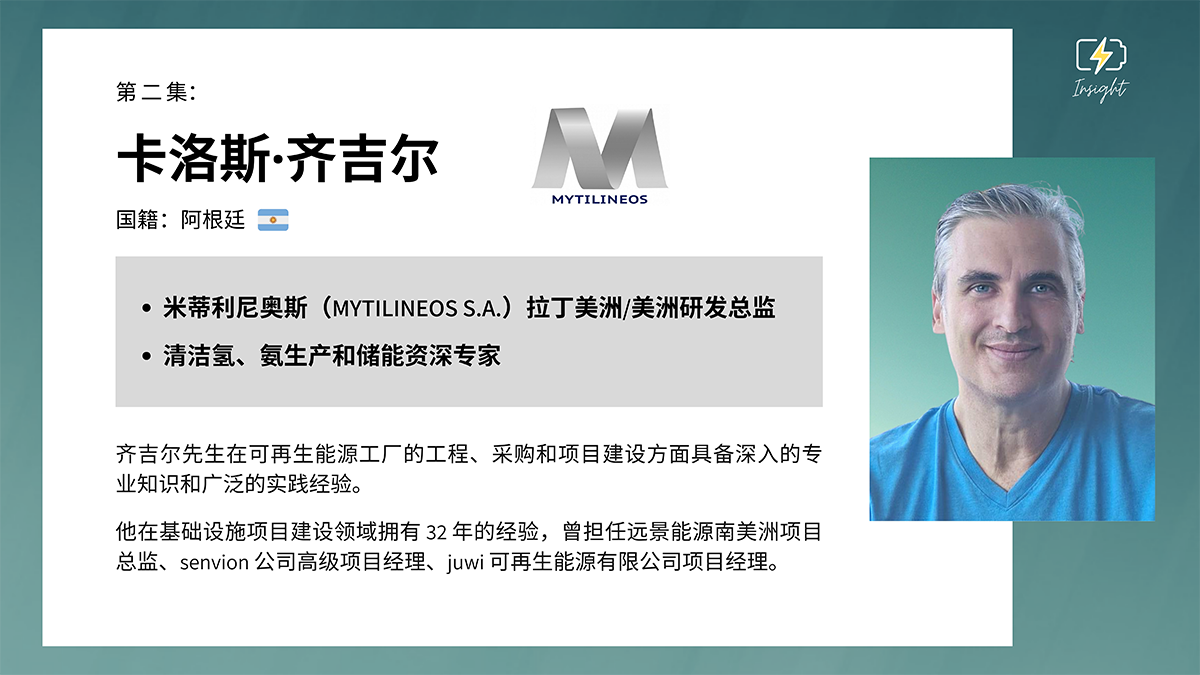储能洞察访谈 第二集:卡洛斯·齐吉尔

齐吉尔先生,您一直是全球脱碳行动和可持续发展目标的支持者。请聊一聊您支持的原因以及您的个人目标。
支持可持续发展目标就是支持人类社会可持续发展,这是一项伟大的事业。应对全球气候变暖,我们需要进行能源转型。能源转型不是二元的,而是多方面的。实现能源转型不仅可以减少气候变化的受灾人数,还能降低全球气候变暖造成的诸多负面影响。当今世界有一半以上的人口生活在城市,预计到2050年,全球城市人口占比将达到十分之七。城市贡献了全球80%以上的GDP,但城市的温室气体排放也占据了全球70%以上。我们要确保到2030年人人都能获得适当、安全和负担得起的住房和基本服务,确保自然遗产、文化遗产得到保护,空气质量、废物管理得到有效提升,人类居住环境得到改善,要促进城乡智能融合发展,将绿色基础设施与气候适应和减缓行动相结合,就必须关注可持续发展目标的复杂性和相互关联性。
我希望我的团队在实现可持续发展目标的过程中可以收获满意的成果和项目,希望他们在工作上得到提升,并坚持为实现不同行业的可持续发展目标努力。为了实现能源转型,我的团队创造了一个用于评估社会-私人能源项目的新模型,叫作“三方双赢模型”,即:一个无限的能源零和游戏。简单来说,我认为从现在开始所有与能源相关的项目都应该基于三方共赢模型,其中第三方指的是生物圈,它应该与其他两方享有相同的权利和义务。这是我的宗旨,也是我的个人目标。
拉丁美洲和加勒比地区可再生能源倡议 (RELAC) 希望到 2030 年实现70%可再生能源并网的电力系统。您认为该如何利用储能实现这一目标?哪些储能技术将发挥关键作用?
到2030年,可再生能源在电力供应中的占比至少应达到70%。但是可再生能源的供应具有不稳定性,无法随时调度。因此储能系统可以发挥发电、输电和配电作用,提高电力系统的灵活性,增加储能容量,避免高峰期电力供应不足的问题。储能系统不仅能保证供电的可靠性和弹性,还能集成多种发电技术,有效减轻环境污染。拥有小型储能系统的家庭或企业,还能节约用电成本。储能系统也能为微电网提供部分谐波治理功能。储能系统可以让企业避免停电造成的电力中断问题,让云计算中心维持互联网运作,让居民规避药品和食品短缺问题,同时保证医疗系统平稳运转。人们还可以选择参与能源生产事业。
至于如何利用储能技术,我认为应该综合利用现有的各种技术,降低成本,进行商业化推广。现在最方便的是电池储能系统 ( BESS )技术,其中锂硫磺电池和钠硫电池最受欢迎,也是最可靠的电池储能技术。
但我认为原材料的成本,尤其是锂和钴,在全球采石场高度集中的背景下,将为南美洲清洁能源储能技术的迅速发展创造战略空间。
国际能源署(IEA)发布的《2022年全球氢能回顾》报告称,智利和阿根廷西部具备独特的发展潜力,有望在 2030 年之前扩大由太阳能和风能制取的低成本绿氢的产量。这两个国家的氢能产业现状如何?您是否认为南美洲可以发展为全球主要的绿氢生产中心?
我想先谈谈我对南美洲氢能产业发展的看法,再聊现状。今天一吨氢气的真正成本是多少?根据《政府指导路线图》,到2030年左右,每千克氢气的成本可能会降至2美元以下,我基本同意这一观点。此外,美国出台了《降低通货膨胀法案》、税收抵免等政策;世界其他地区也有降低清洁能源成本的相关政策。但是根据我们的分析,氢气的生产成本仍然保持在 4 到 6 美元/公斤左右,为什么?
减缓气候变化需要颠覆性的技术,更需要颠覆性的市场模型和生态系统。没有市场驱动的目标是很难实现的。我们需要结合传统的、有价值的市场和新的市场来计算氢的社会和环境价值。
我认为在南美洲建设清洁能源载体区域生态系统的支撑较为薄弱,也存在区域不协调等问题。但南美洲发展可再生能源和清洁燃料的前景广阔,不仅可以满足内部需求,还能满足外部需求,帮助南美洲实现真正的脱碳。我对此非常乐观,也会坚持在南美洲推动全球绿氢生产中心的建设。
氢载体,如氨、甲醇和液态有机氢载体 (LOHC),是目前最有前景的可再生能源储能技术之一,尤其适用于中长期规模的项目。您认为在拉丁美洲,绿氢储存和运输的首选化学原料是什么,决定因素是什么?
清洁氢与CO2捕集综合系统介绍:捕获的CO2与清洁氢反应生成甲烷。由于CO2的储存能力有限,我们应该通过结合使用天然气、储存二氧化碳和可再生能源生产的清洁氢气来回收捕获的二氧化碳。
我认为清洁甲醇是首选的良性氢载体,适用于能源转型和脱碳的中型项目,可用作重型商用车的燃料。它可以大规模生产沼气,它的经济性可与由天然气生产的灰色甲醇相媲美。除此之外还可利用厌氧生物处理技术制取氢气,减少电力使用,打造循环经济。
我认为氨是中等或长期项目的第二大氢载体。由于氨在大气条件下呈气态,气体密度小,因此不适合长距离运输。但在现有的技术中,氨的储存利用具备一定优势。氨可以像丙烷一样在室温条件下以液体形式储存,我们也有相关的储存经验和基础设施。因此将可再生能源转化为可再生氨,这也是能源转型的一个关键选择。
液体有机物储氢是氢气储运的另一种方式,甲苯通过加氢转化为甲基环己烷可用于运输。但我认为首选应该是干净的甲醇和氨水。
除此之外,我认为还可以考虑混氢天然气输氢技术。
能否介绍一下近期开展的储能项目?
我们在智利有几个400兆瓦以上的电池储能系统项目,同时将计划在北美、哥伦比亚和巴西建设500兆瓦以上的项目。除此之外,我们也在开发大型光伏太阳能项目,为南美洲和拉丁美洲供电。
我们还在研究加氢站。这个加氢站将配备1.3 兆瓦电解槽,年产氢量可达130 吨,投资约为 15至2000万美元,用于满足阿根廷国内的氢气需求。加氢站将为国内的燃料电池电动汽车、绿色基础设施项目,尤其是涉及雨水管理的基础设施项目供应氢气。除此之外还有一个城市能源可持续供应系统,这个系统将从雨水、生活用水中制取清洁氢气、沼气和清洁甲醇,为城市供应可持续能源。






